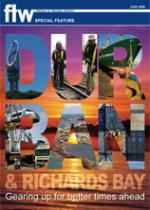Ship repair and ship building at
South African ports remains
something of a Cinderella in the
sense that while it is acknowledged that
these services are necessary, no-one wants
them in their kitchen.
Transnet will in all likelihood be
unhappy with such sentiments, and will
point out how much valuable space is given
over for ship repair in ports like Durban,
Cape Town and East London. But any
scrutiny of Port Master Plans indicates an
alarming inclination towards moving these
facilities aside or even relocating them for
what are seen as more lucrative activities
such as container handling.
The Durban Bayhead is a case in point,
where recent master plans have suggested
that the best solution for Durban ship
building is to relocate to Richards Bay.
On paper this may look like a good idea,
i.e. move all ‘dirty’ cargo to the port that
specialises in bulk cargoes while retaining
‘clean’ cargo like containers close to the
main transport corridor to Gauteng.
But as shipping people, and ship
repairers in particular will tell you, what
looks good on paper does not always work
in reality. Ships don’t plan their mechanical
breakdowns. Nor do ship owners want
to waste valuable time taking their ship
to another port for emergency repairs.
Logically, the ports with the most ship
calls will attract the most repairs – and that
means Durban and Cape Town.
Despite the lack of official support, the
ship repair industry has been remarkably
successful in recent years and has also
begun attracting a degree of ship building,
with seven tugs, several bunker barges
and other vessels under construction in
Durban alone.
In the case of Durban, despite
immeasurable odds, the industry has
managed to keep Durban in the forefront of
ship repair and to resuscitate the
once thriving ship building industry,
using innovation and ingenuity in the
process. Despite the challenges and threats
the industry has also made considerable
investment in the future of Durban
ship repair.
It is a message that those in the industry
have been trying to convince both
government and Transnet, that having
ship repairers available is essential for any
port that caters for large numbers of ships.
Transnet’s own ship repair facilities,
its 80-year-old dry dock, and the more
recently replaced but troublesome
floating dock have been allowed
to deteriorate owing to insufficient
maintenance and care.
Ship repairers using the dry dock are
forced to arrange for private cranes to
replace non-existent dock cranes that
would be regarded as part and parcel of the
service anywhere else in the world.
The private sector and Transnet have
been in discussion for many years over
proposals that the dry dock, in which
Transnet shows no indication of making
investments, be privatised, but so far
to no avail. This is reminiscent of the
story about a ship repair company, Elgin
Brown & Hamer, which applied to place
a floating dock at Cape Town. After five
years of waiting for a response they went
to Namibia and were welcomed with open
arms. Today Walvis Bay has not one but
two identical floating docks in service
with that company and is attracting good
business, much of it business that would
have gone to Cape Town.
Transnet’s own floating dock is another
case in point, having been out of service for
more than a year, while the adjacent Eldock
has enjoyed full occupancy for much of
that time. It appears that the message to the
ship repair industry is that they are on their
own and must muddle along as best they
can without state encouragement.
Fortunately the industry hasn’t muddled
along but is proving both resilient and
successful. There have been numerous
highlights during the past year, including
some major ship repair and refurbishment
contracts with large amounts of steel
replacement after vessels have gone
aground or otherwise suffered failure along
the long southern African coast.
Ship building has shown a strong resurgence, with orders for seven harbour
tugs that are now under construction at
the Durban Southern African Shipyards at
a cost in excess of R500 million. Several
bunker barges have been completed at
Dormac Marine and others double-hulled
in accordance with the latest MARPOL
requirements.
Dormac Marine has announced plans to
build its own 240m long dry dock with a
width of 40m on the company site
at Bayhead.
Many people in the shipping industry
regard this as extremely ambitious
yet it may never have been necessary
had the Transnet dry dock question
been addressed.
SA Shipyards is meanwhile importing
a small floating dock, ostensibly to use as
a launch vehicle for the tug shipbuilding
programme although it would be naive to
think this will not be used for ship repair
in the future.
These projects and other ordinary ship
repairs undertaken by the many companies
and sub-contractors and suppliers add
immeasurably to the importance of
Durban as a port, while also increasing
and adding value to the skills base of
the city and environs and, of course,
generating substantial amounts of capital
for the region.
Ship repair gets relegated for more profitable pursuits
25 Jun 2009 - by Terry Hutson
0 Comments
Durban & Richards Bay 2009

25 Jun 2009
25 Jun 2009
25 Jun 2009
25 Jun 2009
25 Jun 2009
25 Jun 2009
25 Jun 2009
25 Jun 2009
Border Beat
Poll
Featured Jobs
New
